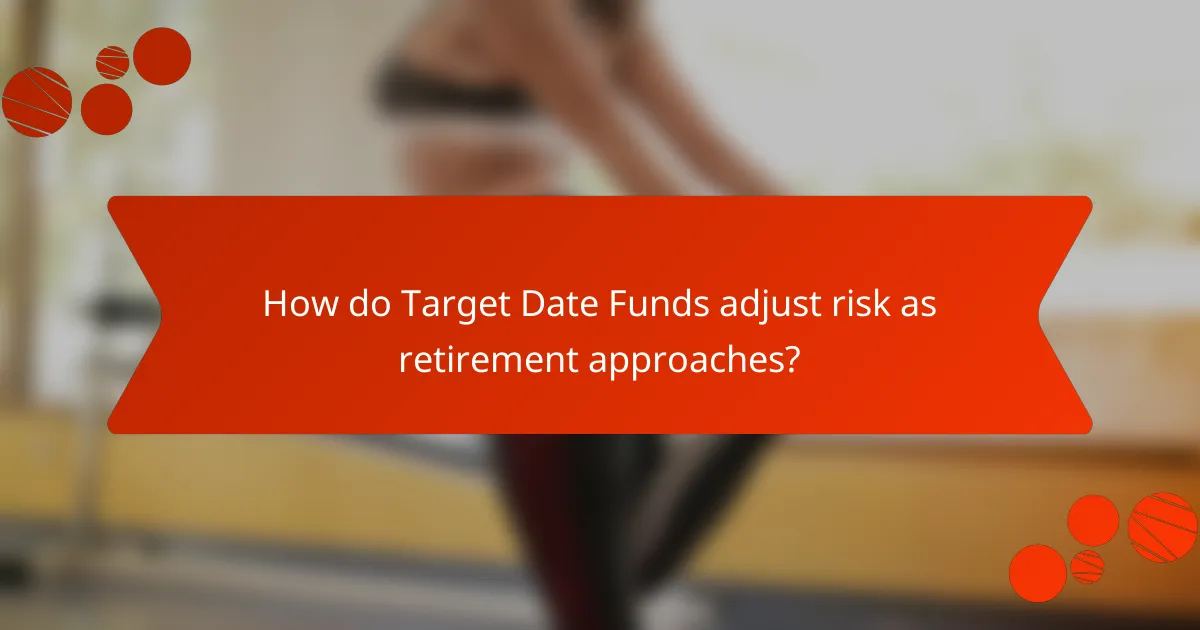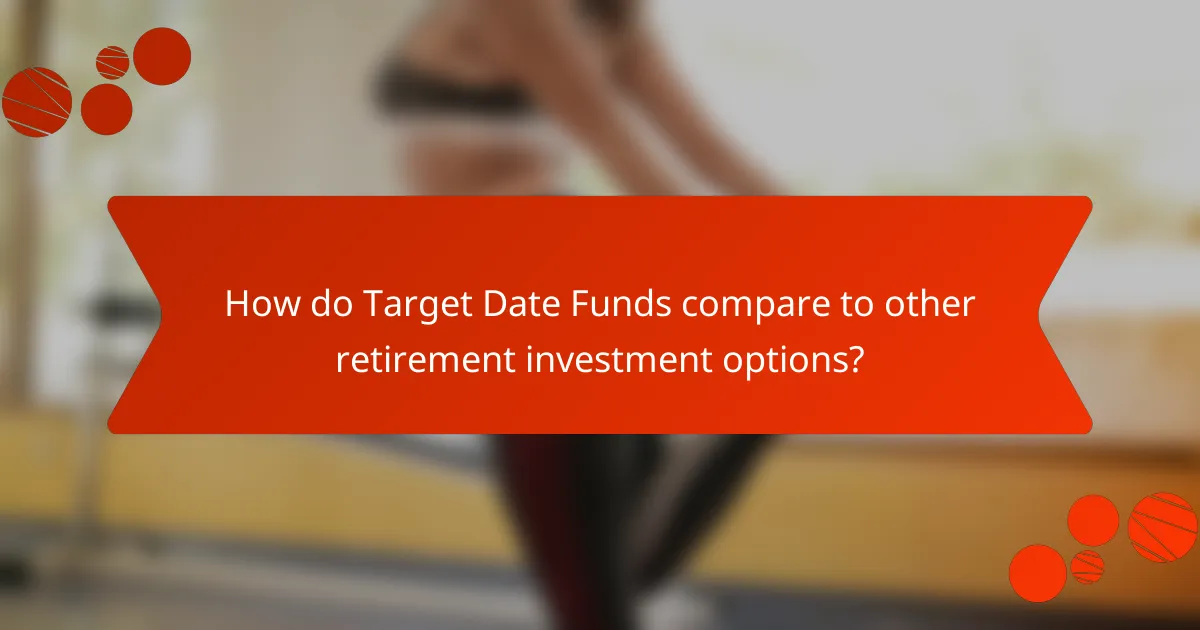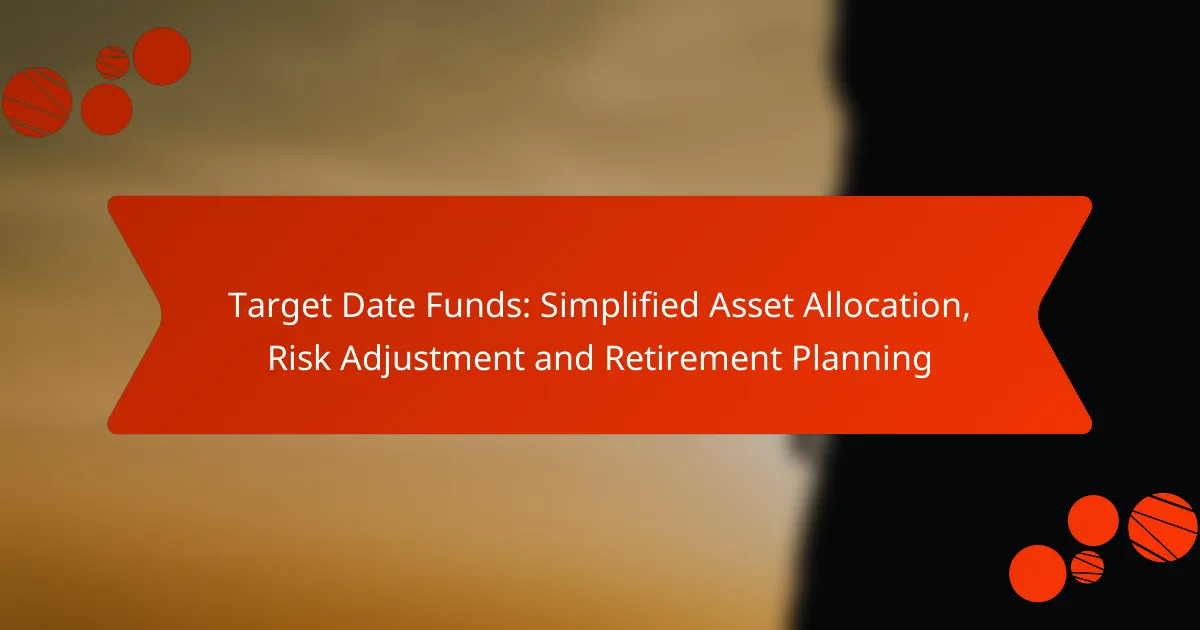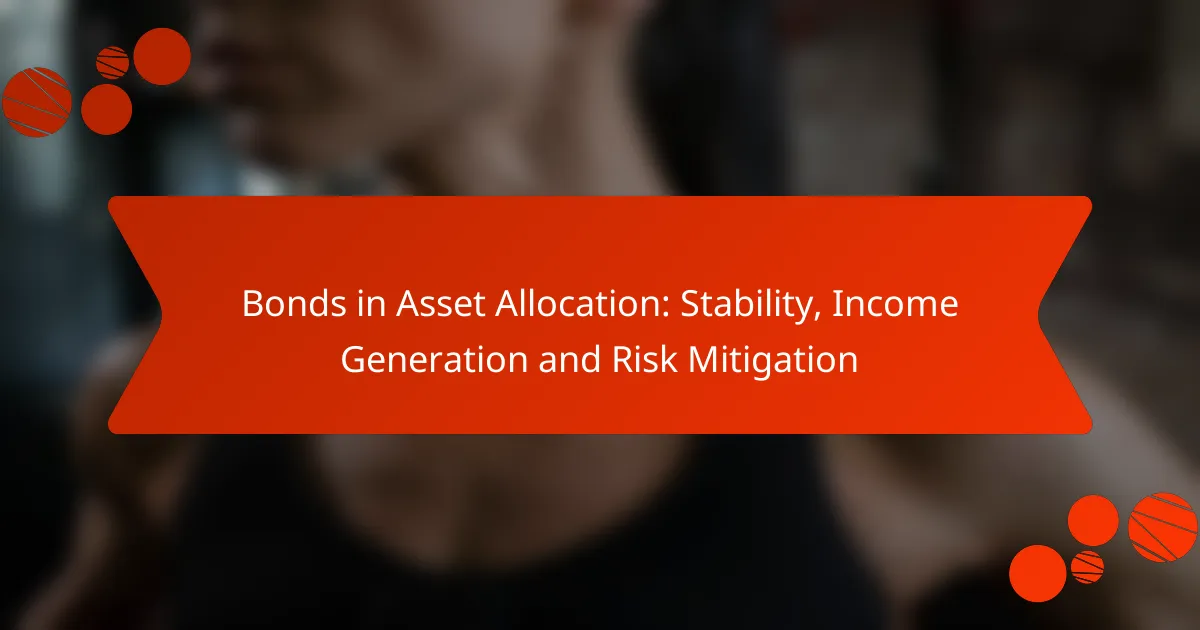Target date funds offer a streamlined approach to asset allocation by automatically adjusting investments based on a predetermined retirement date. This method enables investors to concentrate on their long-term objectives without the burden of ongoing portfolio management. As the target date approaches, these funds gradually shift from higher-risk to more conservative assets, aiming to safeguard capital while still promoting growth during the accumulation phase.

How do Target Date Funds simplify asset allocation?
Target date funds simplify asset allocation by automatically adjusting the mix of assets based on a specified retirement date. This approach allows investors to focus on their long-term goals without needing to constantly manage their investment portfolio.
Automatic rebalancing
Target date funds feature automatic rebalancing, which means the fund manager regularly adjusts the asset allocation to maintain the target mix. This helps ensure that the investment strategy remains aligned with the fund’s objective as market conditions change.
For example, if stocks perform well and make up a larger portion of the fund than intended, the manager will sell some stocks and buy bonds to restore the original balance. This process occurs without requiring any action from the investor.
Age-based investment strategy
Target date funds employ an age-based investment strategy, gradually shifting from higher-risk assets, like stocks, to lower-risk assets, such as bonds, as the target date approaches. This strategy is designed to match the risk tolerance of investors as they near retirement.
Typically, younger investors may see a higher percentage of their portfolio in equities, while those closer to retirement will have a greater allocation in fixed-income securities. This shift helps protect the investment from market volatility as the retirement date nears.
Risk reduction over time
Risk reduction over time is a fundamental principle of target date funds. As investors age, the fund’s allocation becomes more conservative, reducing exposure to market fluctuations. This approach aims to preserve capital and minimize potential losses as retirement approaches.
For instance, a target date fund aimed at a retirement date in the next decade might allocate around 60% to equities and 40% to bonds initially. As the target date nears, this allocation could shift to 30% equities and 70% bonds, reflecting a lower risk profile.

What are the risks associated with Target Date Funds?
Target date funds carry several risks that investors should be aware of, including market volatility and potential high fees. Understanding these risks can help individuals make informed decisions about their retirement planning and asset allocation.
Market volatility exposure
Target date funds are designed to adjust their asset allocation as the target date approaches, typically becoming more conservative over time. However, during the accumulation phase, these funds can still be significantly exposed to market volatility, which may lead to fluctuations in the fund’s value. Investors should be prepared for potential downturns, especially if they are nearing retirement.
For example, if a target date fund is heavily invested in equities, a market downturn could result in a substantial loss of value. It’s essential for investors to regularly review their fund’s performance and understand the underlying asset mix to gauge their exposure to market risks.
Potential high fees
Many target date funds come with higher fees compared to traditional mutual funds, which can erode returns over time. These fees may include management fees, expense ratios, and other costs associated with fund management. It’s crucial for investors to compare fees across different target date funds to ensure they are not overpaying.
Investors should look for funds with lower expense ratios, ideally in the low single digits, as high fees can significantly impact long-term growth. Always read the fund’s prospectus to understand the fee structure and consider how these costs align with your investment goals.

How do Target Date Funds adjust risk as retirement approaches?
Target date funds adjust risk by gradually shifting their asset allocation from higher-risk investments to more conservative ones as the target retirement date nears. This strategy aims to protect the investor’s capital while still allowing for growth in the years leading up to retirement.
Gradual shift to conservative assets
As the target date approaches, target date funds typically reduce their exposure to equities and increase their allocation to fixed-income securities. This gradual shift helps to minimize volatility and preserve capital, which is crucial for individuals nearing retirement. For example, a fund might start with an allocation of 80% stocks and 20% bonds, transitioning to a more conservative mix of 40% stocks and 60% bonds over time.
Investors should be aware that this shift is not a one-time event but rather a continuous process that occurs over several years. The specific timeline and allocation percentages can vary by fund, so reviewing the fund’s glide path is essential for understanding how risk is managed.
Dynamic asset allocation strategies
Dynamic asset allocation strategies involve adjusting the fund’s investments based on market conditions and economic forecasts. This approach allows fund managers to respond to changing risks and opportunities, potentially enhancing returns while managing risk. For instance, if the market experiences a downturn, a fund may temporarily increase its bond allocation to protect against losses.
Investors should consider that while dynamic strategies can offer flexibility, they also introduce additional complexity. It’s important to evaluate the fund’s historical performance and the manager’s track record in navigating market fluctuations. Understanding the fund’s strategy can help investors align their risk tolerance with their retirement goals.

What factors should you consider when choosing a Target Date Fund?
When selecting a Target Date Fund, consider the fund’s expense ratios, underlying asset mix, and performance history. These factors will help you assess the fund’s cost-effectiveness, investment strategy, and past returns, which are crucial for aligning with your retirement goals.
Expense ratios
Expense ratios indicate the annual fees charged by a fund, expressed as a percentage of assets. Lower expense ratios can significantly enhance your returns over time, especially in a long-term investment like a Target Date Fund. Aim for funds with expense ratios in the low range, typically below 0.5%.
Be cautious of funds with high fees, as they can erode your investment gains. Always compare the expense ratios of similar funds to ensure you are getting the best value for your investment.
Underlying asset mix
The underlying asset mix of a Target Date Fund determines its risk profile and potential returns. These funds typically shift from a higher allocation in equities to a more conservative mix of bonds as the target date approaches. Review the fund’s current asset allocation to ensure it aligns with your risk tolerance and investment timeline.
For instance, a fund targeting retirement in 2040 may have around 80% in stocks and 20% in bonds, while one targeting 2020 might reverse that allocation. Understanding this mix helps you gauge how the fund will perform in different market conditions.
Fund performance history
Evaluating a Target Date Fund’s performance history provides insights into its ability to meet its investment objectives. Look for funds that have consistently outperformed their benchmarks over various market cycles. However, past performance is not a guarantee of future results.
Consider funds with a track record of delivering returns that align with their risk profile. A fund that has managed to maintain steady growth while minimizing losses during downturns can be a more reliable choice for your retirement savings.

How do Target Date Funds compare to other retirement investment options?
Target date funds (TDFs) are designed to simplify retirement investing by automatically adjusting asset allocation based on a specified retirement date. Compared to traditional mutual funds and index funds, TDFs offer a more hands-off approach, making them appealing for investors seeking convenience and gradual risk reduction as they near retirement.
Versus traditional mutual funds
Target date funds differ from traditional mutual funds primarily in their investment strategy and management style. While traditional mutual funds require investors to actively manage their portfolios and make decisions about asset allocation, TDFs automatically adjust their mix of stocks, bonds, and other assets over time based on the target retirement date.
This automatic rebalancing can be beneficial for those who may not have the time or expertise to manage their investments actively. However, traditional mutual funds may offer more flexibility and potentially higher returns if managed effectively, as they can be tailored to individual risk tolerances and investment goals.
Versus index funds
When comparing target date funds to index funds, the key difference lies in their structure and management. Index funds aim to replicate the performance of a specific market index, providing broad market exposure at a low cost. In contrast, TDFs are actively managed to adjust their asset allocation over time, which can lead to higher fees compared to typical index funds.
Investors may prefer index funds for their low expense ratios and simplicity, especially if they are comfortable managing their own asset allocation. However, TDFs can be more suitable for those who want a set-it-and-forget-it investment strategy that gradually becomes more conservative as retirement approaches, thus reducing risk over time.

What are the tax implications of Target Date Funds?
Target date funds offer specific tax implications primarily related to their structure and investment strategy. These funds typically provide tax-deferred growth, meaning investors do not pay taxes on earnings until they withdraw funds, which can be beneficial for retirement planning.
Tax-deferred growth
Tax-deferred growth allows investors in target date funds to accumulate earnings without immediate tax liabilities. This means that dividends and capital gains generated within the fund are not taxed until the investor withdraws money, usually during retirement when they may be in a lower tax bracket.
For example, if a target date fund generates a return of 6% annually, that entire amount can be reinvested without incurring taxes. This can significantly enhance the compounding effect over time, potentially leading to a larger retirement nest egg.
However, investors should be aware that withdrawals from these funds are taxed as ordinary income. It’s advisable to plan withdrawals strategically to minimize tax impacts, especially in years when other income is lower.

